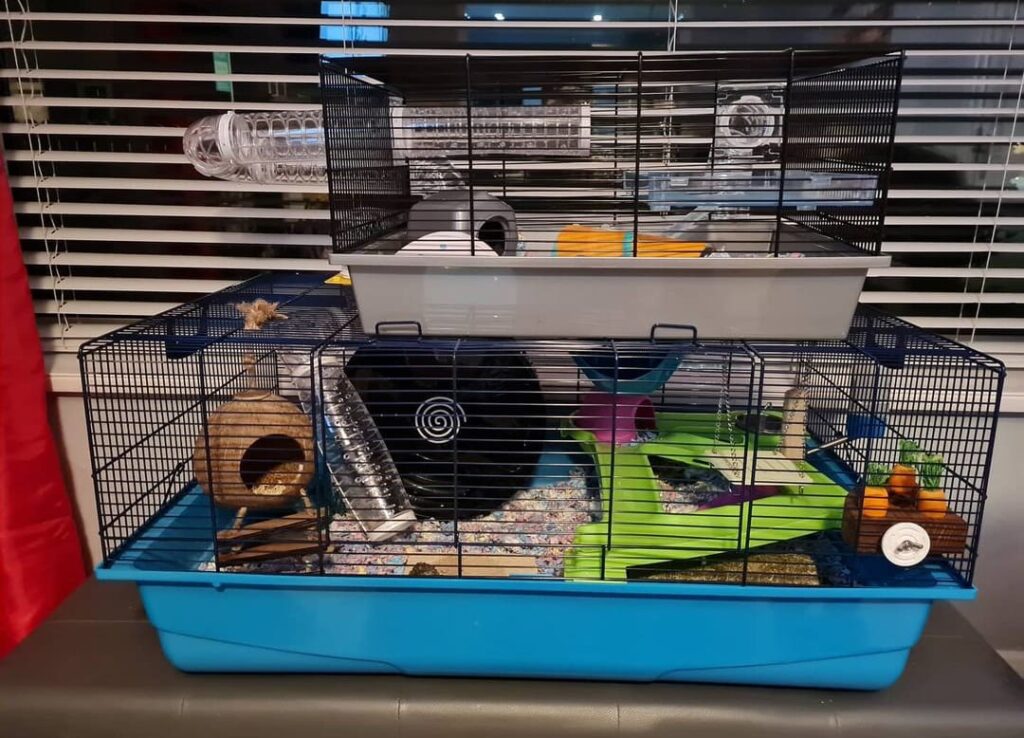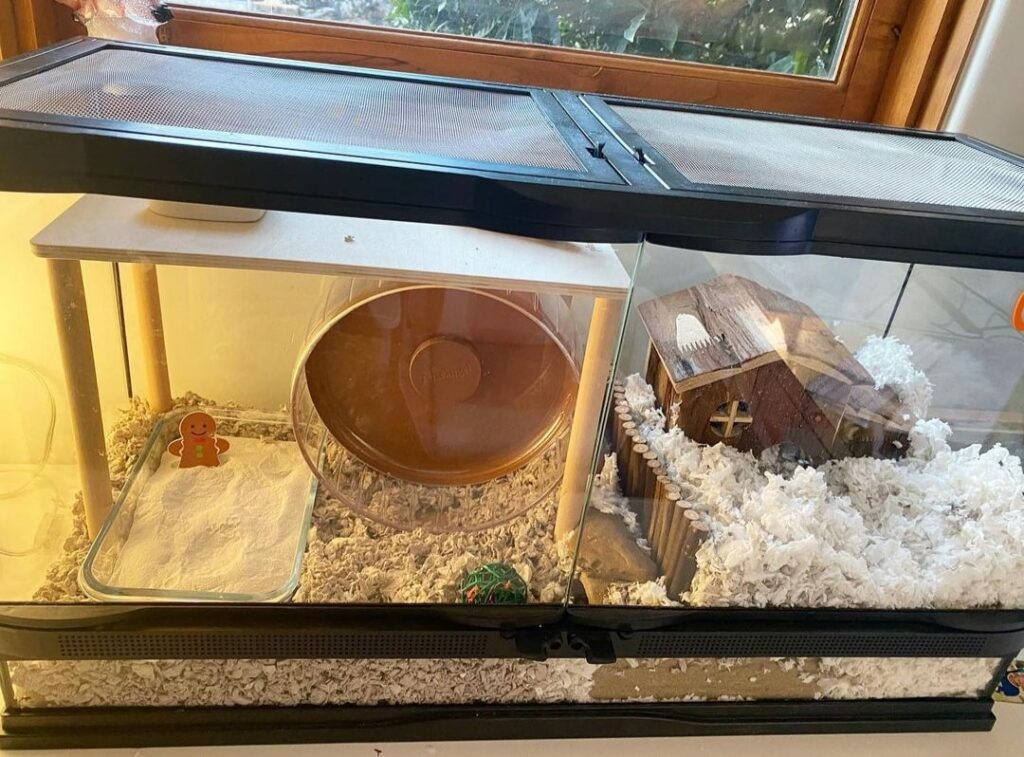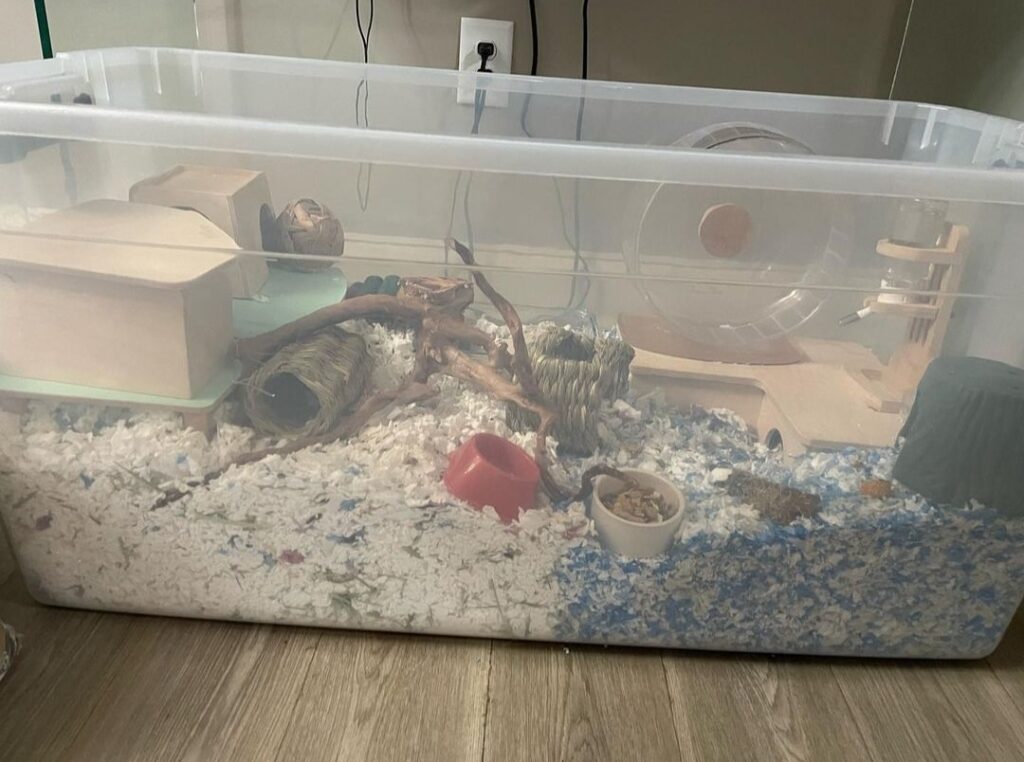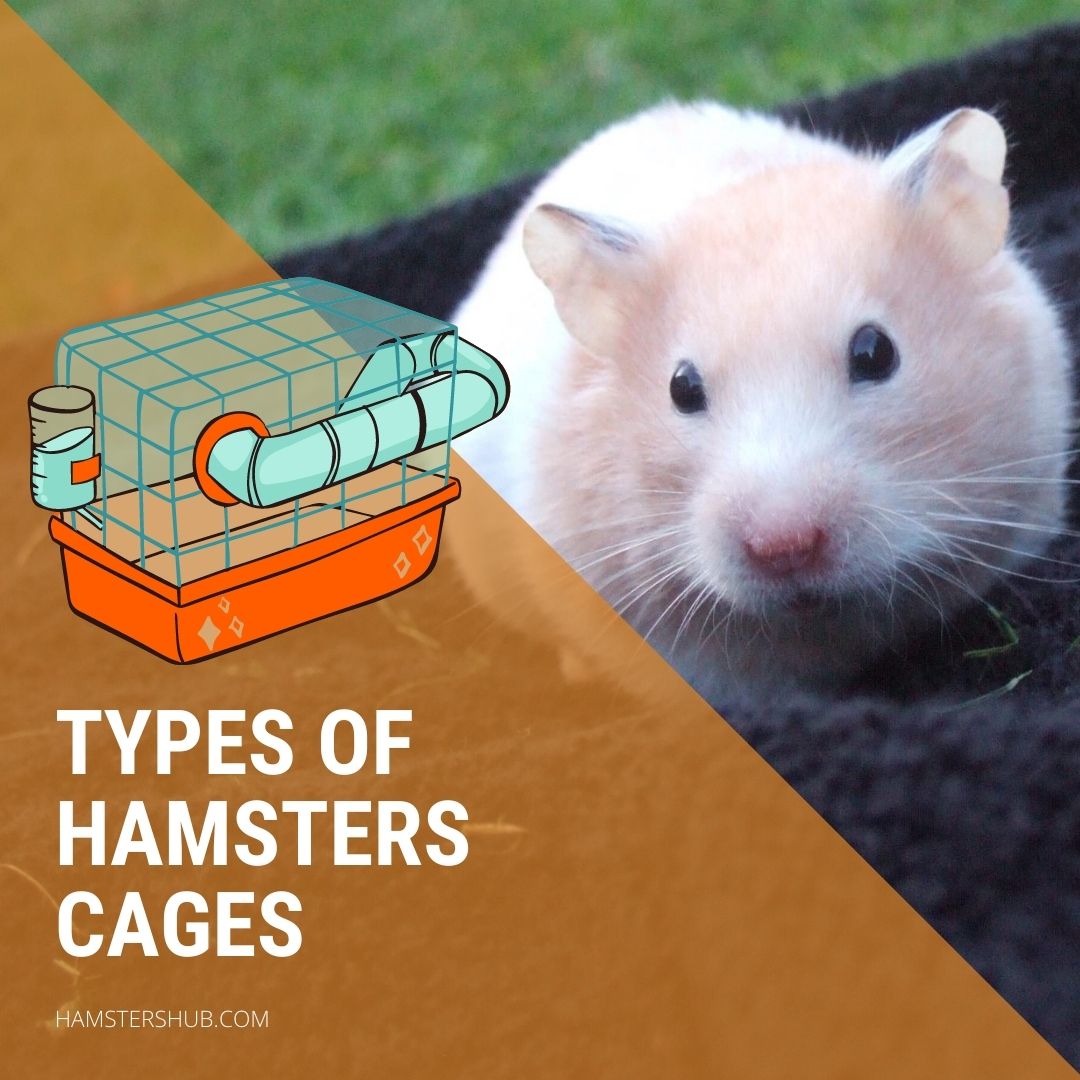With the growing popularity of hamsters as household pets, the requirements for hamster cages have grown over time. Thus, there are many hamster cage options in the market for different budgets.
Also, due to many inappropriate cages, people have discovered a few awesome options you can try if you’re new.
Here I’ve discussed various types of hamster cages and their pros and cons, and I’ll try to put their approximate cost. So let’s check and find out what suits your need.
1. Metal and Wire Cages
Metal and Wire Cages are one of the oldest types of hamster cages on the market. Bird cages inspire wire cages; often, in the market, they try to sell bird cages in the name of hamster cages.
These types of wire cages can have unneeded vertical spaces, which can be problematic for hamsters, as your hamster can escape through these spaces.
Hamsters don’t need much space to escape; their body is too flexible, and if somehow they pass their head through the bars, they can also pass their whole body.
Due to various reasons, hamsters often try to escape the cage, so you must keep that in mind.

Thus, you have to ensure the cage bars are no more than half an inch apart. If you have a baby hamster, it can pass through between cage wires. For that reason, it will be great if the sides are solid.
So it is advised not to put your Dwarf Hamster in a wire cage as they can squeeze through the bars and escape, and they run faster than Syrian hamsters. Also, wire cages are not good for bedding, and dwarf hamsters need more deep bedding for burrowing than Syrians.
Also, the oldest wire cages have a metal bottom, which is not good because the hamster’s urine can cause corrosion and rust, which is not good for hamsters’ health.
Additionally, many wire cages have drawers that can stop working with corrosion and rust, so cleaning will be difficult for you. Thus, if you purchase a wire cage, go with a plastic bottom.
Cages with wire bottoms can hurt the tiny feet of your hamster, so please avoid that type of cage.
Here is an example of a wire cage with a plastic bottom on amazon; it is about 528 sq inches in size, more than recommended 450 sq inch size.

Pros
- Easy to get at local as well as online stores.
- Cost-effective.
- Wire cages also have good ventilation.
- It is also good for small spaces.
- Hamsters often climb the cage bars as they love climbing.
- If the top of the cage has bars, they swing across it. [Ensure a good bedding depth so it won’t damage them if they fall]
Cons
- A wire cage with a metal bottom can cause corrosion and rust in hamsters’ urine, which is a health hazard and also damage the cage.
- Wire cages are not that safe, as hamsters can escape through the wire bars. Thus, try to avoid it.
- If you have a Dwarf hamster, never use wire cages.
- Wire cages come with unsecured sliding doors, so use a padlock if you have the same.
- Big wire cages for ferrets and rabbits are unsafe for hamsters; go for small rat and hamster cages.
- As wire cages have good airflow, the outside smell travels easily into the cage.
Due to that many cons, most hamster owners don’t like wire cages. I’ve mentioned better options below.
If we talk about the price, you can get wire hamster cages for as low as $40 and as high as $150 or more.
2. Habitat-style Cages
Habitat-style cages basically created to fulfill hamsters’ natural habitat, like burrowing, digging, and others. In 1970 the brand Habitarail first launched habitat-style cages for hamsters and other rodents.
This type of cage is filled with multiple items like tubes, wheels, and other accessories. Even the main cage is a group of small cages connected together, so hamsters can go in different chambers.
Most of these cages are built with plastic, so there won’t be any issue of corrosion. Also, due to the different boxes, cleaning is easy.
Those habitat-style cages are also popular among kids, as they can assemble as they want and play. But are Habitat-style cages good for hamsters?
Most Habitat-style cages are unsuitable for hamsters; they might look attractive to your kids, but remember that hamsters are not toys to play with. They should be treated properly, hamsters need a lot of space due to their natural habit of traveling, but habitat-style cages are small and not ideal for hamsters.
Different brands have made those habitat-style cages to attract kids and generate huge profits. Hamsters need a lot of space to remain out of stress, so don’t go with these kinds of short cages; rather, use bin cages.
However, a few goods and big options are available on the market, but it is hard to find and not cost-effective.
Here I’ve discussed more about hamsters’ cage size and how they matter a lot for them to maintain a relaxed and healthy life.
Moreover, I have also seen many habitat-style cages that don’t have properly sized accessories (wheels, tubes, and others) which can harm your hamster.
These cages have multiple small levels, which is unsuitable; hamsters need at min 450 sq inches of unbroken floor space, meaning an entire cage of that size, not multiple levels or chambers.
3. Aquarium or Terrarium
Although Aquarium is made for fish and reptiles, it can be a really good cage for your hamster due to its large space and availability on the market. Not only these two but there are also so many advantages of having an Aquarium.

As most aquariums have an all-glass or plastic design, there won’t be a corrosion issue. Secondly, the bad smell from hamsters’ urine is an issue for your hamster in metal bottom cages; glass or plastic will solve this issue.
An aquarium is made entirely of glass or plastic; it is safe or escape-proof for dwarf hamsters, whereas small hamsters can escape through wire cages.
Hence, if you don’t have large cage options, then Aquarium is a great option for you; not only me, but most hamster owners recommend using an Aquarium over those small cages due to so many benefits.
So if you’ve decided to go with an Aquarium, ensure it is 40 gallons or more, and also, it should be all glass or plastic; avoid using a metal frame.
Additionally, you have to make the lid with wire (wire should be hard enough so the hamster can not chew) to maintain good airflow for your hamster.
Pros
- Large space
- Easily available on the market
- Solid bottom and sides, making your hamster cage secure and escape-proof
- Easy to clean
- Corrosion-free cage.
- You can put deep bedding.
- A used Aquarium can also work fine if cleaned neatly and is not damaged.
Cons
- Aquariums can be more costly than other cages.
- You have to make the ventilation lid with wire mesh. [However, often you can get the ventilated lid from the market with the aquarium]
Here is a 40-gallon tank you can check on amazon.
4. Bin Cages or Plastic Storage Boxes
Plastic Storage boxes or Bin Cages are new inventions; many people use big plastic storage boxes as hamsters’ cages. It is bigger and better than small cages on the market.
This cage’s main advantage is that it is inexpensive, and you can find them easily on the market. Apart from this, there are other benefits of using Bin Cages.

Pros
- Bin Cages are inexpensive and can be found easily on the market.
- It is Transparent, so you can easily see your hamster.
- Lightweight and easy to move.
Cons
- You need to make the lid for ventilation.
- The plastic of the cage should not be soft, as hamsters can chew or swallow it.
- For warm places, plastic is not the best suit.
If you’re planning to get Bin Cage, make sure the size should be over 50 gallons, you can also go for a bigger bin cage.
You can also visit your nearest pet store and ask them for bin cages; if it is available, they may also have a ventilation lid, so you can just buy it, or you can make the ventilation lid with wire mesh.
The plastic box cages in pet stores are also solid and suitable for hamsters. But do check before buying the plastic box, as soft plastic is not good for hamsters.
So not all and every plastic storage will work; only hard plastic cages are suitable. Also, don’t place this type of cage in a warm room.
5. DIY or Homemade Cages
In the market, getting the best cage for hamsters is difficult. If the size is good, then the material is not, and lots of others. Thus, a DIY hamster cage can fulfill most of your needs.
Many hamster owners prefer using a DIY homemade cage to other small cages. However, if you don’t have various tools like a saw, drill, and others, you may have issues, but you can get help from your nearest carpenter.
Pros
- You can get a big cage or the size that you want.
- You can use materials that you want and are suitable for hamsters.
- Often you can make a DIY cage cheaper than market cages.
- Easy to clean.
Cons
- You have to spend a lot of time and work to make it.
- You need a few tools like saw, drill, and others available to make the cage.
To build a DIY hamster cage, first, you need to know what size you want; then, you can measure the length, width, height, and bottom. For sides and bottom, you can use wood [ensure the wood is thick and safe for hamsters or the wood doesn’t contain formaldehyde].
For one side or length, you have to use glass to watch your hamster, you can order online, and you can pay extra to cut the glass to your desired size.
Tip: You can first make the whole cage like sides and bottom with wood and then measure the glass and order online.
After making the cage, for the top, you also need to make a ventilation lid with wire mesh so your hamster gets proper airflow. You have to use hard wire to make the mesh.
Lastly, you can use safe, natural varnish to coat the bottom to protect it from hamster urine. You can also use safe glue if you need to attract the wood properly.
Here are two of my best DIY cage-making videos on YouTube; you can check these out.
6. Travel Cages
Travel cages are not used as your hamster’s house, but if you’re moving somewhere, you can use these travel cages to move your hamster with you. These cages are small, and you can easily carry the cage with you.
Although I did not want to mention the travel cage here, as here, I’ve mainly informed you guys about the housing cages; for your information, I’ve listed this at the bottom.
So, Which Hamster Cage Should You Buy?
The answer depends on you because before buying the cage, you need to make sure your budget, hamster species, the space you have for your hamster in your room, and your capability of making a cage, as well as cage options in your country and others.
To make it easier for you, if you have a low budget, you can make your own Bin Cage and insert the enrichments your hamster need.
Suppose you have a big cage available offline or online; you can order a wire and plastic bottom cage from there; also, make sure you go with a wire cage if it is a Syrian hamster; Dwarf hamsters can escape from wire bars.
However, you can avoid wire cages and use Aquariums, Bin, and DIY cages.
If you want big cages and no wire, you can use an Aquarium or make a DIY hamster cage. If you feel that making a DIY cage would be hard, then Aquarium is a great option for you, but Aquarium can cost a few extra. However, you can have a secondhand Aquarium.
And don’t buy small cages from the pet shop; they have their own story to convince you but don’t fall into the trap.
Things to Check Before Buying a Hamster Cage
- The Cage Should be Big: As mentioned at the start, you must have a cage that is big enough for your hamster to do various activities with provided enrichment.
- Proper Ventilation: Good ventilation is needed for any pets you put into a cage. So if you’re using a solid cage made with wood, glass, or other, ensure there is enough airflow.
- Escape Proof: As mentioned, hamsters can easily escape through small spaces or gaps. Thus, make sure your cage does not have large gaps, especially for wire cages.
- Easy to Clean: The cage should be big and easy to put your hands on and spot clean, as you have to clean a lot. Here is a post written to show how to clean hamsters’ cages.
- Made with Safe Material: This point is vital if you’re making the cage yourself or a carpenter. You have to be careful what material you’re using; if you’re using wood, you have to ensure it doesn’t contain any formaldehyde. You should not add paints, varnish, etc.

